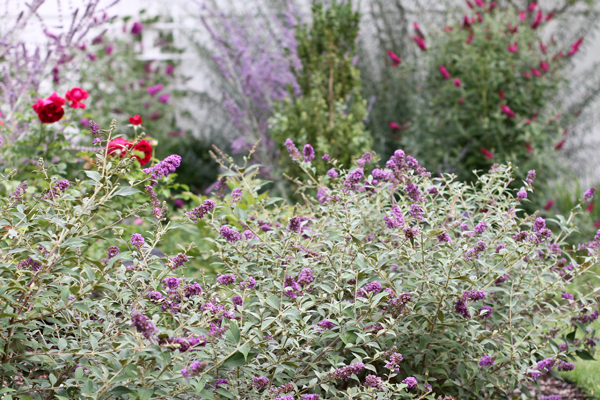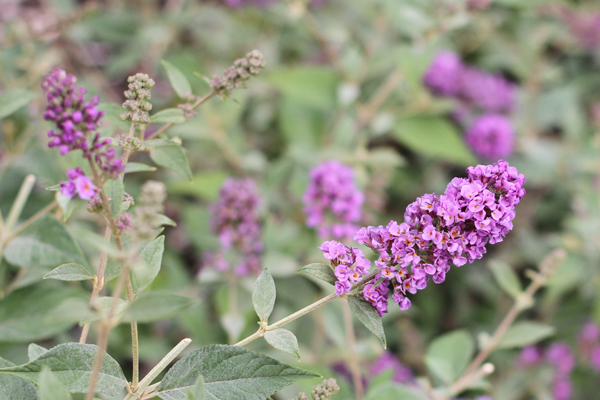September 29, 2015
Roses and Crabapples in a Vase on Tuesday
In this recent fall arrangement I used branches from my 'Royal Raindrops' crabapple trees for the first time in a vase. I intended to participate in Cathy's 'In a Vase on Monday' meme but didn't get around to posting until Tuesday. That's just the way life goes around here.
The base of the arrangement was formed by crimson 'William Shakespeare 2000' and pink 'Royal Jubilee' English roses. Black leaves from 'Chocoholic' Cimicifuga helped fill in around the flowers. Spikes of 'Miss Molly' butterfly bush shot out from the right side.
I also included a few late-blooming stems of 'Moulin Rouge' Astrantia (masterwort, above) and 'Invincibelle Spirit' hydrangea (not shown).
Tiny crabapples contributed to the fall feel, and blushing stems from my 'Peach Sorbet' blueberry bushes added more interesting foliage.
Japanese Anemone (A. robustissima) arched above the cluster of larger flowers.
The anemones are so pretty they get a second photo.
Yesterday the temperature dropped to 31 degrees Fahrenheit in the early morning and froze the water in my bird bath. The flowers escaped this time but the end is near!
September 21, 2015
Garden Views on a September Evening
As the season draws to a close, the backyard garden is looking fairly full, at least from some angles. It is very soothing to spend a few minutes there in the evening.
The flowers are mostly shades of violet with a few reddish butterfly bushes in the mix. Next year there will be more maroon leaves in this scene with the additions of a 'Red Dragon' contorted filbert and a 'Royal Purple' smoke bush.
Four Russian sage (Peroskvia) plants are especially lovely when a breeze waves their flower wands back and forth.
As you see, the honey locusts (Gleditsia 'Shademaster') are already turning yellow for fall. Near the bottom of the photo the dark green leaves of 'Totally Tangerine' geum still look fresh despite a long, hot summer. I didn't even cut them back after blooming; they're just sturdy.
'Farmington' double asters bloom next to the 'Buzz Purple' butterfly bush. Pollinators love both of these plants.
The overgrown dwarf Arctic willow is kind of a thug but so graceful that I happily keep it around. Next spring I need to use a shovel to cut back the roots as well as cutting the branches nearly back to the ground to help it stay smaller. In the meantime I have to keep reminding my kids that they are NOT allowed to whip each other with the wiry stems.
September 15, 2015
Japanese Anemones for GBBD September 2015
The stars of the garden right now are the Japanese anemones (A. robustussima) in the northeast corner of the backyard. The lavender in the background above comes from a 'Rozanne' geranium. Both the anemones and the geranium attract crowds of bees and other pollinators.
Japanese anemones are known for being aggressive spreaders through their rhizomes, and mine have indeed been spreading. I just keep digging up the unwanted shoots and tossing them in the green bin, because I do want some of these lovely plants in my garden.
Their curvy stems are pretty in the garden or in a vase, and the pearl-like buds are attractive even before they open.
Dainty leaves form a nice backdrop for the flowers. Anemones are supposed to be hardy down to zone 5, which is what I consider my garden, but our winters have murdered several other varieties. Anemone robustissima is the hardiest and the survivor of several winters in my garden.
Who would guess that such an ethereal looking flower would spread like a thug? I wouldn't recommend this plant for fluffy soils, as the spreading would get really hard to contain. It's not as bad in clay soil, though.
The other lovely blooms right now are on the 'Little Lime' hydrangeas. Usually we get a frost before the flowers have time to turn deep rose, but this year the deeper color has developed well.
The leaves are starting to color, the sun is low and the sky is a deeper shade of blue. Happy fall! Thanks to Carol of May Dreams Gardens for hosting Garden Bloggers Bloom Day.
September 9, 2015
Crimson William Shakespeare Roses in a Vase
Last week I put together this flamboyantly colored vase of crimson 'William Shakespeare' and mauve 'Sister Elizabeth' roses. With spikes from 'Buzz Purple' butterfly bushes and 'Pink Princess' foxgloves in the mix, it turned out a little brighter than I usually like. But the great thing about fresh flowers is they die before you get tired of the colors!
William Shakespeare roses have a delicious old rose scent, and Sister Elizabeth smells of myrrh. The Pink Princess foxgloves bridged the color gap between the two types of roses, with mauve coloring at the tips and crimson shading at the base of each vase-shaped flower.
For texture I included some interesting flower bracts from 'Amethyst Falls' ornamental oregano (above) . . .
. . . as well as my favorite Dr. Suess-esque clematis seed pods and 'Fama' pincushion flower (Scabiosa) seed pods.
To make a base for the flowers, I used 'Black Lace' elderberry (Sambucus) leaves. Then I added stems of curly willow (Salix) and honeysuckle (Lonicera) to arch out from the center. Cuttings from Japanese anemone (A. robistussima) contributed pearl-like buds on curving stems.
All that pink and purple turned out slightly psychedelic. This week I'm back to pale roses on my table, but that's a post for another day.
September 4, 2015
Buzz Purple, Miss Molly, Miss Ruby and Blue Chip
Today I write about the four types of butterfly bushes (Buddleia) in my grarden. Butterfly bushes are great for late summer color, and they really do attract crowds of butterflies, hummingbirds, and fuzzy bumblebees. Above is 'Buzz Purple,' with spikes of 'Caradonna' salvia in front (on its second flush of bloom for the year) and an overgrown dwarf Arctic willow in back. Can you believe I cut that willow back to the ground this spring?
Here are the flowers of 'Buzz Purple' up close. All the Buzz butterfly bushes - there are other colors available - are supposed to stay dwarf at 2-3 feet tall and wide, but mine has grown to about 5 feet tall and 4 feet wide this summer. Four to five feet is still smaller than the old cultivars that grew 8-10 feet.My climate is so cold that all the butterfly bushes die back to the ground each year, so in warmer climates I bet this shrub would grow even larger. Of course you can control the size no matter where you live by cutting the bushes down to the ground each spring. The nice thing about this series is that they have very little reseeding, unlike older cultivars which could be invasive.
Above is 'Miss Molly,' a Proven Winners selection that is supposed to grow 4-5 feet tall and 5-6 feet wide with no reseeding. Both of mine grew that tall but stayed really skinny this summer. I'm not sure if that's what they will do every summer or if this odd shape is due to specific climate conditions. I'll have to wait until next year to see.
'Miss Molly' is advertised as the reddest butterfly bush available, with the red color more pronounced in warmer climates. I have noticed the flowers that open during hot spells are more red than the ones that open during cooler times.
I planted this 'Miss Ruby' bush earlier this summer, so it hasn't had time to grow to its full size. Its color is a softer, cooler pink than 'Miss Molly,' though its predicted size is the same as MM. Butterfly bushes are hardy in zones 5-9 and prefer full sun and well-drained soil. They are supposed to be deer resistant as well.
Here you see the flowers of 'Miss Ruby' up close, with a dying spike of flowers at the bottom. Eventually the bloomed-out flower spikes fade to black. They don't look awful if you don't get around to deadheading, but the shrubs do look better if they are regularly deadheaded.
My final butterfly bush is 'Blue Chip' from the Proven Winners Lo and Behold series. This type has actually stayed dwarf through several seasons, growing to about 2 feet tall and wide. I have 6 of these in the backyard and they haven't reseeded, as promised.
The color of 'Blue Chip' is less flamboyant than the other bushes in my garden, and the butterflies seem to prefer the shrubs with brighter colors. But I still see a few butterflies and hummingbirds on this type.
This summer I have enjoyed cutting flower spikes from the butterfly bushes to use in floral arrangements. They last several days in a vase and work really well with my English Roses. That is yet another reason to find a spot for a butterfly bush in the garden, especially with these newer, smaller, noninvasive cultivars available.
Subscribe to:
Comments (Atom)

































